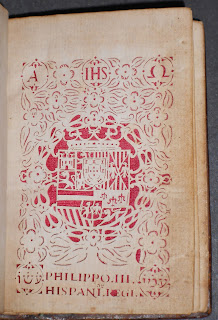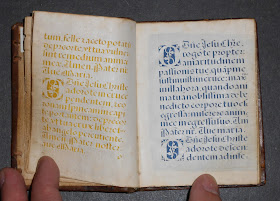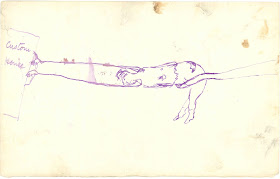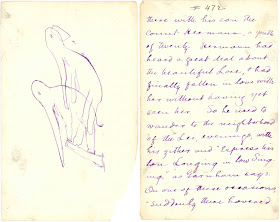 Bound in a gilded, but otherwise unassuming, contemporary calfskin binding, this little book seems much like any other until you open to the title page. At this point it becomes obvious that you are not looking at a normal book. What might at first glance appear to be text and image printed in red ink quickly resolves itself into an intricately cut page. Yes, cut. Each letter in this book, which measures 3 ¾ x 2 ¾ inches, been cut through the vellum and then a piece of colored silk has been inserted between the pages. The intricate carvings appear, due to the variations in the size and angle of the letters, to have been hand cut without the use of a stencil or guide. The silk backings include red, green, yellow, blue and black.
Bound in a gilded, but otherwise unassuming, contemporary calfskin binding, this little book seems much like any other until you open to the title page. At this point it becomes obvious that you are not looking at a normal book. What might at first glance appear to be text and image printed in red ink quickly resolves itself into an intricately cut page. Yes, cut. Each letter in this book, which measures 3 ¾ x 2 ¾ inches, been cut through the vellum and then a piece of colored silk has been inserted between the pages. The intricate carvings appear, due to the variations in the size and angle of the letters, to have been hand cut without the use of a stencil or guide. The silk backings include red, green, yellow, blue and black.
 So what is it and why? Unfortunately we know little about this book. It is dedicated to and executed for Philip III of Spain and bears his coat-of-arms on the title page. The text, a collection of church and private prayers in Latin, is likely the work of the Dominican monk Diego de Barrada who probably did it to show his devotion and loyalty to the king. The book was completed in ca. 1600 as a gift to King Philip III. Beyond this, we don't know much about this book, nor has anyone on our staff seen a similar example.
So what is it and why? Unfortunately we know little about this book. It is dedicated to and executed for Philip III of Spain and bears his coat-of-arms on the title page. The text, a collection of church and private prayers in Latin, is likely the work of the Dominican monk Diego de Barrada who probably did it to show his devotion and loyalty to the king. The book was completed in ca. 1600 as a gift to King Philip III. Beyond this, we don't know much about this book, nor has anyone on our staff seen a similar example.Ask for Codex 001599.
You can also read about a more modern take on negative space in an earlier post.



